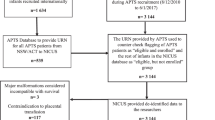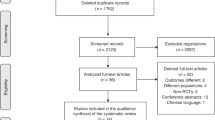Abstract
Artificial placenta and artificial womb technologies to support extremely premature neonates are advancing toward clinical testing in humans. Currently, no recommendations exist comparing these approaches to guide study design and optimal enrollment eligibility adhering to principles of research ethics. In this paper, we will explore how scientific differences between the artificial placenta and artificial womb approaches create unique ethical challenges to designing first-in-human trials of safety and provide recommendations to guide ethical study design for initial human translation.
This is a preview of subscription content, access via your institution
Access options
Subscribe to this journal
Receive 12 print issues and online access
$259.00 per year
only $21.58 per issue
Buy this article
- Purchase on Springer Link
- Instant access to full article PDF
Prices may be subject to local taxes which are calculated during checkout
Similar content being viewed by others
References
Westin B, Nyberg R, Enhorning G. A technique for perfusion of the previable human fetus. Acta Paediatr (Stock). 1958;47:339–49.
Philip AGS. The Evolution of Neonatology. Pediatr Res. 2005;58:799–815.
Gray BW, El-Sabbagh A, Rojas-Pena A, Kim AC, Gadepali S, Koch KL, et al. Development of an artificial placenta IV: 24 h venovenous extracorporeal life support in premature lambs. ASAIO J. 2012;58:148–54.
Gray BW, El-Sabbagh A, Zakem SJ, Koch KL, Rojas-Pena A, Owens GE, et al. Development of an artificial placenta V: 70 h veno-venous extracorporeal life support after ventilatory failure in premature lambs. J Pediatr Surg. 2013;48:145–53.
Church JT, Coughlin MA, Perkins EM, Hoffman HR, Barks JD, Rabah R, et al. The artificial placenta: Continued lung development during extracorporeal support in a preterm lamb model. J Pediatr Surg. 2018;53:1896–903.
Church JT, Werner NL, Coughlin MA, Menzel-Smith J, Najjar M, Carr BD, et al. Effects of an artificial placenta on brain development and injury in premature lambs. J Pediatr Surg. 2018;53:1234–9.
El-Sabbagh AM, Gray BW, Shaffer AW, Bryner BS, Church JT, McLeod JS, et al. Cerebral Oxygenation of Premature Lambs Supported by an Artificial Placenta. ASAIO J. 2018;64:552–6.
Partridge EA, Davey MG, Hornick MA, Flake AW. An EXTrauterine environment for neonatal development: EXTENDING fetal physiology beyond the womb. Semin Fetal Neonatal Med. 2017;22:404–9.
Partridge EA, Davey MG, Hornick MA, McGovern PE, Mejaddam AY, Vrecenak JD, et al. An extra-uterine system to physiologically support the extreme premature lamb. Nat Commun. 2017;8:15112.
Hornick MA, Davey MG, Partridge EA, Mejaddam AY, McGovern PE, Olive AM, et al. Umbilical cannulation optimizes circuit flows in premature lambs supported by the EXTra-uterine Environment for Neonatal Development (EXTEND). J Physiol. 2018;596:1575–85.
Hornick MA, Mejaddam AY, McGovern PE, Hwang G, Han J, Peranteau WH, et al. Technical feasibility of umbilical cannulation in midgestation lambs supported by the EXTra-uterine Environment for Neonatal Development (EXTEND). Artif Organs. 2019;43:1154–61.
Ozawa K, Davey MG, Tian Z, Hornick MA, Mejaddam AY, McGovern PE, et al. Fetal echocardiographic assessment of cardiovascular impact of prolonged support on EXTrauterine Environment for Neonatal Development (EXTEND) system. Ultrasound Obstet Gynecol. 2020;55:516–22.
Miura Y, Matsuda T, Usuda H, Watanabe S, Kitanishi R, Saito M, et al. A Parallelized Pumpless Artificial Placenta System Significantly Prolonged Survival Time in a Preterm Lamb Model. Artif Organs. 2016;40:E61–68.
Usuda H, Watanabe S, Miura Y, Saito M, Musk GC, Rittenschober-Böhm J, et al. Successful maintenance of key physiological parameters in preterm lambs treated with ex vivo uterine environment therapy for a period of 1 week. Am J Obstet Gynecol. 2017;217:457.e1–457.e13.
Miura Y, Usuda H, Watanabe S, Woodward E, Saito M, Musk GC, et al. Stable Control of Physiological Parameters, But Not Infection, in Preterm Lambs Maintained on Ex Vivo Uterine Environment Therapy. Artif Organs. 2017;41:959–68.
Usuda H, Watanabe S, Saito M, Ikeda H, Koshinami S, Sato S, et al. Successful use of an artificial placenta-based life support system to treat extremely preterm ovine fetuses compromised by intrauterine inflammation. Am J Obstet Gynecol. 2020;223:755.e1–755.e20.
Romanis EC. Artificial womb technology and the significance of birth: why gestatelings are not newborns (or fetuses). J Med Ethics. 2019;45:728–31.
Colgrove N. Subjects of ectogenesis: are ‘gestatelings’ fetuses, newborns or neither? J Med Ethics. 2019;45:723–6.
Rodger D, Colgrove N, Blackshaw BP. Gestaticide: killing the subject of the artificial womb. J Med Ethics. 2021;47:e53.
Werner KM, Mercurio MR. Ethical considerations in the use of artificial womb/placenta technology. Semin Perinatol. 2022;46:151521.
Romanis EC. Artificial womb technology and the frontiers of human reproduction: conceptual differences and potential implications. J Med Ethics. 2018;44:751–5.
van der Hout-van der Jagt MB, Verweij EJT, Andriessen P, de Boode WP, Bos AF, Delbressine FLM et al. Interprofessional Consensus Regarding Design Requirements for Liquid-Based Perinatal Life Support (PLS) Technology. Front Pediatr. 2021;9:793531.
Sahoo T, Gulla KM. Artificial placenta: Miles to go before I sleep…. Am J Obstet Gynecol. 2019;221:368–9.
De Bie FR, Davey MG, Larson AC, Deprest J, Flake AW. Artificial placenta and womb technology: Past, current, and future challenges towards clinical translation. Prenat Diagn. 2021;41:145–58.
Abecassis M. Artificial Wombs: The Third Era of Human Reproduction and the Likely Impact on French and U.S. Law. Hastings Women’s LJ. 2016;27:3–27.
Alghrani A. Viability and abortion: lessons from ectogenesis? Expert Rev Obstet Gynecol. 2009;4:625–34.
Cohen IG. Artificial Wombs and Abortion Rights. Hastings Cent Rep. 2017;47:inside back cover. https://doi.org/10.1002/hast.730.
Verweij EJ, De Proost L, van Laar JOEH, Frank L, Obermann-Borstn SA, Vermeulen MJ et al. Ethical Development of Artificial Amniotic Sac and Placenta Technology: A Roadmap. Front Pediatr. 2021;9:793308.
National Commission for the Protection of Human Subjects of Biomedical and Behavioral Research, The Belmont Report: Ethical Principles and Guidelines for the Protection of Human Subjects of Research. Washington, DC: U.S. Government Printing Office;1979.
Appelbaum PS, Roth LH, Lidz CW, Benson P, Winslade W. False hopes and best data: consent to research and the therapeutic misconception. Hastings Cent Rep. 1987;17:20–4.
SUPPORT Study Group of the Eunice Kennedy Shriver NICHD Neonatal Research Network, Carlo WA, Finer NN, Walsh MC, Rich W, Gantz MG, et al. Target ranges of oxygen saturation in extremely preterm infants. N Engl J Med. 2010;362:1959–69.
Schmidt B, Whyte RK, Asztalos EV, Moddemann D, Poets C, Rabi Y, et al. Effects of targeting higher vs lower arterial oxygen saturations on death or disability in extremely preterm infants: a randomized clinical trial. JAMA. 2013;309:2111–20.
Lantos JD, Feudtner C. SUPPORT and the Ethics of Study Implementation: Lessons for Comparative Effectiveness Research from the Trial of Oxygen Therapy for Premature Babies. Hastings Cent Rep. 2015;45:30–40.
Mychaliska GB, Bealer JF, Graf JL, Rosen MA, Adzick NS, Harrison MR. Operating on placental support: the ex utero intrapartum treatment procedure. J Pediatr Surg. 1997;32:227–30.
Lannon SMR, Guthrie KA, Vanderhoeven JP, Gammill HS. Uterine rupture risk after periviable cesarean delivery. Obstet Gynecol. 2015;125:1095–100.
Adzick NS, Thom EA, Spong CY, Brock JW, Burrows PK, Johnson MP, et al. A Randomized Trial of Prenatal versus Postnatal Repair of Myelomeningocele. N Engl J Med. 2011;364:993–1004.
Hendriks S, Grady C, Wasserman D, Wendler D, Bianchi DW, Berkman BE. A New Ethical Framework for Assessing the Unique Challenges of Fetal Therapy Trials. Am J Bioeth. 2022;22:45–61.
Shah LD, Lantos J, Hunt C, McFadyen A, Escandon R, Bateman-House A. Fetal Therapies and Clinical Research: Beyond Risk and Benefit. Am J Bioeth. 2022;22:1–3.
Meadow W, Meadow X, Tanz RR, Lagatta J, Lantos J. The value of a trial of therapy - football as a ‘proof-of-concept’. Acta Paediatr. 2011;100:167–9.
Tyson JE, Parikh NA, Langer J, Green C, Higgins RD. National Institute of Child Health and Human Development Neonatal Research Network. Intensive care for extreme prematurity–moving beyond gestational age. N Engl J Med. 2008;358:1672–81.
Rysavy MA, Li L, Bell EF, Das A, Hintz SR, Stoll BJ, et al. Between-hospital variation in treatment and outcomes in extremely preterm infants. N Engl J Med. 2015;372:1801–11.
Bell EF, Hintz SR, Hansen NI, Bann CM, Wyckoff MH, DeMauro SB, et al. Mortality, In-Hospital Morbidity, Care Practices, and 2-Year Outcomes for Extremely Preterm Infants in the US, 2013–8. JAMA. 2022;327:248–63.
Cummings J. Committee on fetus and newborn. Antenatal Counseling Regarding Resuscitation and Intensive Care Before 25 Weeks of Gestation. PEDIATRICS. 2015;136:588–95.
Church JT, Kim AC, Erickson KM, Rana A, Drongowski R, Hirschl RB, et al. Pushing the boundaries of ECLS: Outcomes in <34 week EGA neonates. J Pediatr Surg. 2017;52:1810–5.
Brisbois EJ, Handa H, Major TC, Bartlett RH, Meyerhoff ME. Long-term nitric oxide release and elevated temperature stability with S-nitroso-N-acetylpenicillamine (SNAP)-doped Elast-eon E2As polymer. Biomaterials. 2013;34:6957–66.
Fallon BP, Lautner-Csorba O, Major TC, Lautner G, Harvey SL, Langley MW, et al. Extracorporeal life support without systemic anticoagulation: a nitric oxide-based non-thrombogenic circuit for the artificial placenta in an ovine model. Pediatr Res. 2023. https://doi.org/10.1038/s41390-023-02605-2
Charest-Pekeski AJ, Sheta A, Taniguchi L, McVey MJ, Floh A, Sun L, et al. Achieving sustained extrauterine life: Challenges of an artificial placenta in fetal pigs as a model of the preterm human fetus. Physiol Rep. 2021;9:e14742.
Balasubramaniam J, Del Bigio MR. Animal models of germinal matrix hemorrhage. J Child Neurol. 2006;21:365–71.
NICHD Neonatal Research Network (NRN): Extremely Preterm Birth Outcome Data. NIH Eunice Kennedy Shriver National Institute of Child Health and Human Development. https://www.nichd.nih.gov/about/org/der/branches/ppb/programs/epbo/pages/epbo_case.aspx (accessed 1 May2017).
Weiss EM, Kukora S, Barrington KJ. Use of composite NICU research outcomes for goals of care counselling creates ethical challenges. Acta Paediatr. 2021;110:3251–4.
Haward MF, Luu TM, Pearce R, Janvier A. Personalized support of parents of extremely preterm infants before, during and after birth. Semin Fetal Neonatal Med. 2022;27:101335.
Kukora SK, Boss RD. Values-based shared decision-making in the antenatal period. Semin Fetal Neonatal Med. 2017. https://doi.org/10.1016/j.siny.2017.09.003
Weiss EM, Guttmann KF, Olszewski AE, Magnus BE, Li S, Kim SYH, et al. Parental Enrollment Decision-Making for a Neonatal Clinical Trial. J Pediatr. 2021;239:143–.e3.
Weiss EM, Olszewski AE, Guttmann KF, Magnus BE, Li S, Shah AR, et al. Parental Factors Associated With the Decision to Participate in a Neonatal Clinical Trial. JAMA Netw Open. 2021;4:e2032106.
U.S. Department of Health and Human Services, Food and Drug Administration, Office of Good Clinical Practice, Center for Drug Evaluation and Research, Center for Biologics Evaluation and Research, Center for Devices and Radiological Health. Guidance for Institutional Review Boards, Clinical Investigators, and Sponsors Exception from Informed Consent Requirements for Emergency Research. March 2011, updated April 2013. https://www.fda.gov/media/80554/download
Author information
Authors and Affiliations
Contributions
Dr SKK co-conceptualized the project, drafted the initial paper and critically revised it, contributed content expertize in neonatal bioethics and antenatal counseling. Dr GBM critically revised the paper and contributed content expertize on artificial placenta and artificial womb technology. Dr EW co-conceptualized the project, critically revised the paper, and contributed content expertize on neonatal research ethics.
Corresponding author
Ethics declarations
Competing interests
The authors declare no competing interests.
Additional information
Publisher’s note Springer Nature remains neutral with regard to jurisdictional claims in published maps and institutional affiliations.
Rights and permissions
Springer Nature or its licensor (e.g. a society or other partner) holds exclusive rights to this article under a publishing agreement with the author(s) or other rightsholder(s); author self-archiving of the accepted manuscript version of this article is solely governed by the terms of such publishing agreement and applicable law.
About this article
Cite this article
Kukora, S.K., Mychaliska, G.B. & Weiss, E.M. Ethical challenges in first-in-human trials of the artificial placenta and artificial womb: not all technologies are created equally, ethically. J Perinatol 43, 1337–1342 (2023). https://doi.org/10.1038/s41372-023-01713-5
Received:
Revised:
Accepted:
Published:
Issue Date:
DOI: https://doi.org/10.1038/s41372-023-01713-5



